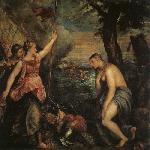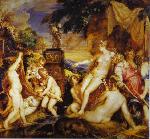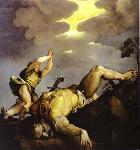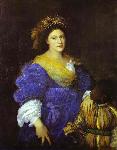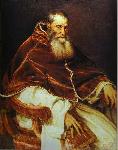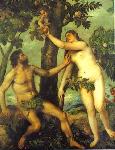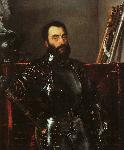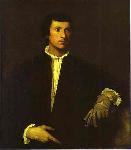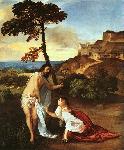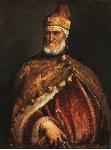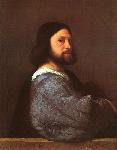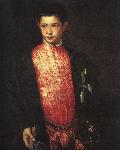Learn About Titian in Art History. View His Art and Famous Paintings
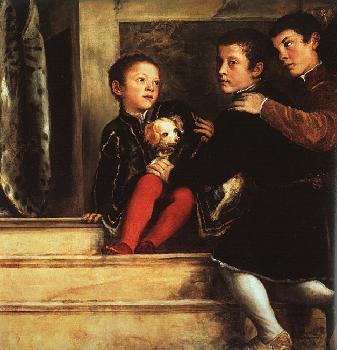
Titian, "Votive Portrait of the Vendramin Family(Detail)", 1543-47
Titian, 1485-1576, one of Italy’s famous artists in art history painted three famous, rather orgiastic paintings designed for a pleasure chamber owned by the Duke of Ferrara, in 1518-23. The first art painting is "Festival of Venus", painted in 1518-19.
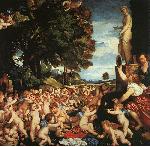 Amorous and hungry Cupids are everywhere busy collecting golden apples kissing each other in front of the statue Venus. Another Cupid shoots love arrows while a maenad reaches out toward Venus holding a mirror.
Amorous and hungry Cupids are everywhere busy collecting golden apples kissing each other in front of the statue Venus. Another Cupid shoots love arrows while a maenad reaches out toward Venus holding a mirror.
Titian’s second painting is "Bacchanal of the Andrians", painted in 1520.The inhabitants of the island of Andros are under the influence of wine and love. Different stages of inebriation cause them to do a variety of different things. The figure on the far left hasn't had enough wine and has the entire jug to himself. The female figure in the right foreground lies naked and satiated, while the local God lies drunk on a distant hill.
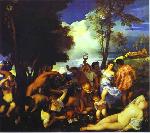
The third famous painting, "Bacchus and Ariadne"1522-23, pictures Bacchus swiftly springing from his chariot to save Ariadne, abandoned by Theseus.The God is attended by a rowdy band of drunken maenads clashing cymbals.
Titian was the first painter in modern times to loosen the exactness of his brushwork.
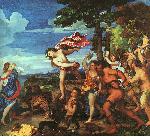 He converted the atmospheric art perspective into expressions of emotion and surface tension. He would apply paint over a pre-painted reddish ground giving his colors warmth, then adding layers of glaze softening and harmonizing the colors.
He converted the atmospheric art perspective into expressions of emotion and surface tension. He would apply paint over a pre-painted reddish ground giving his colors warmth, then adding layers of glaze softening and harmonizing the colors.
Experiencing a kind of artful rebirth, and a compositional change, He painted three biblical scenes, in 1542. The paintings were intensely active. The figures were monumental, heroic, muscular figures, all in life threatening circumstances.
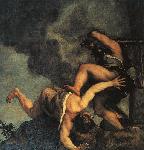
In "Cain Killing Able", "Sacrifice of Isaac", and in "David and Goliath" the point of view is startlingly low. The viewer is beneath the action watching as the figures twist and turn across the picture plane. The clouds, the atmosphere, as well as the figures, are interpenetrated by light and color adding to the emotional mood of the artwork.
Toward the last part of Titian's career in art history, his brushwork became freer. Lines softened using quick broader brushstrokes losing their linear integrity.
An example is "Danae", painted in 1554.
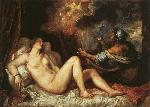 Jupiter is showing love toward Danae showering her with golden coins while a greedy, ugly, maidservant reaches out with her apron stealing some of the coins.Looser brushwork adds emotion and drama to the artwork.
Jupiter is showing love toward Danae showering her with golden coins while a greedy, ugly, maidservant reaches out with her apron stealing some of the coins.Looser brushwork adds emotion and drama to the artwork.
He blurred spatial relationships between foreground and background in the "Rape of Europe", 1559-62.
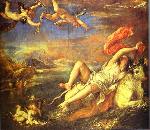 The sky, mountains, water, and foreground all fuse together in a colorful atmospheric art effect. Variations of these characteristics are visible in his paintings the remainder of his life.
The sky, mountains, water, and foreground all fuse together in a colorful atmospheric art effect. Variations of these characteristics are visible in his paintings the remainder of his life.
Another of Titian's famous paintings "Crowning with Thorns", painted in 1570, creates a compositional art drama with the bright white highlight of Christ's clothing and quick active brushstrokes.

He leads us into and through the action with the light from Christ's clothing attracting our eye to the center of the painting. Pulled back to the foreground figure we follow his upraised arm holding a weapon rallying the attackers. Our eye moves to the muscular figure on the left who fends off a driving blow from the upraised arms of the fighter on the right and back again to the head of Christ.
In his more formal art compositions, he uses all sorts of triangles and diagonals to balancing his compositions and moving the viewers throughout his paintings.
Another of Titian's famous paintings in art history "Entombment", was painted in 1576.
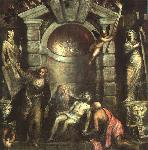 Moses is high on the left, and Mary is on the right carrying the cross. Beneath Mary and the lion head is a small picture of him praying with his son. Directly to the left is his recognizable face playing the part of Saint Jerome. A putto holds Mary Magdalen's oil jar, while she raises her arm in grief at the death of Jesus Christ. Left of the flying putto is a mosaic of a pelican striking its breast, a traditional symbol of Christ's sacrifice for mankind. Other famous artists of the Renaissance period are Giorgione and Raphael.
Moses is high on the left, and Mary is on the right carrying the cross. Beneath Mary and the lion head is a small picture of him praying with his son. Directly to the left is his recognizable face playing the part of Saint Jerome. A putto holds Mary Magdalen's oil jar, while she raises her arm in grief at the death of Jesus Christ. Left of the flying putto is a mosaic of a pelican striking its breast, a traditional symbol of Christ's sacrifice for mankind. Other famous artists of the Renaissance period are Giorgione and Raphael.
To view selected paintings and increase their size, click on the graphics below
